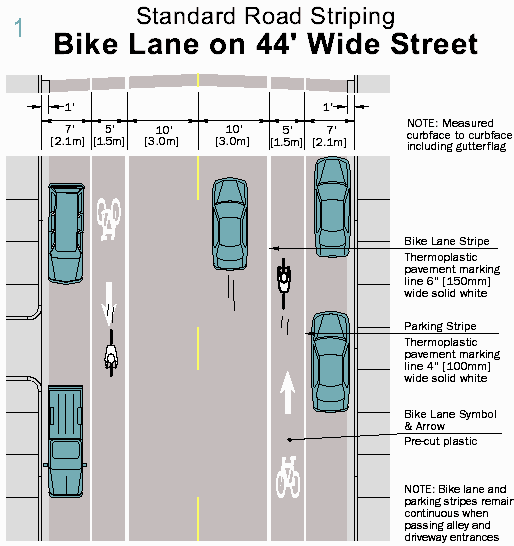
The Bike Lane Design Guide --"Honey, they shrunk the cars!"by John S. Allen (Article written 2006; links updated 2017) (In case you, my reader, aren't versed in American popular culture, the line in quotes above refers to the title of a Disney movie.) Now, back to the serious discussion. The Bike Lane Design Guide, published in 2002 by the Pedestrian and Bicycle Information Center of the University of North Carolina in cooperation with the Chicagoland Bicycle Federation and the City of Chicago, recommends dimensions for installation of bike lanes on urban streets. Each page of plans in the Bike Lane Design Guide is formatted to look like a dimensioned engineering drawing, and stamped with the seal of the City of Chicago. Version #1of the image that appears below (numbered in upper left corner) is as it appears on page 7 of the Bike Lane Design Guide. The four other versions have been modified by the author of this page. Click through them and try to figure out what they tell you. Scroll down when done to see my answers below the image. |

Here are some issues highlighted by the comparison:
There is heated controversy in the bicycling community about bike lanes. Many advocates of transportation reform seize upon bike lanes as a simple, seemingly logical way to increase the appeal of bicycling. These people tend to regard the use of road space as a political turf battle between bicyclists and motorists, and to use expressions such as "making space for bicyclists". On the other hand, people who have explored issues of safety, mobility and political unintended consequences disparage bike lanes where the highest safe travel speed is 5 miles per hour, which attract inexperienced, trusting bicyclists into hazardous situations, and which lead the non-bicycling majority of the public to become annoyed with bicyclists who refuse what they perceive as a special privilege. This is a classic example of a controversy between people who believe that the ends justify the means, on the one hand, and people who value the rights and safety of the individual, on the other. The controversy often goes overboard into a stark "bike lanes vs. no bike lanes" dispute, and that is unfortunate because bike lanes can be appropriate and useful -- but only if certain conditions are met. One important condition is that a bike lane must allow bicyclists to travel safely at their normal speed of 10 to 25 miles per hour. (Some good examples -- and bad ones too -- are shown here and here.) The bike lanes adjacent to parallel parking shown in the Bike Lane Design Guide do not pass. The Bike Lane Design Guide is harmful in suggesting inappropriate bike lane designs, and so in turning attention away from other measures which are effective and safe. In using deceptive illustrations labeled as dimensioned engineering drawings, the Bike Lane Design Guide certainly does nothing to enhance the credibility of the organizations that produced it. |
The vehicles used as models in the comparison drawings are
Some passenger vehicles, particularly older, larger two-door cars, are wider than those shown -- as wide as 80 inches and with a 44-inch door protrusion. Bicyclists must merge slightly farther left than shown in the fourth illustration to clear these safely -- and even farther left to clear large trucks and buses safely. A graph showing the width of representative parallel-parked vehicles to the limit of the driver's side door when open is available on another Web page prepared by the author of this one. References: The Bike Lane Design Guide, posted on the Web site of NACTO, the national Association of City Traffic Officials (Originally posted on pedbikeinfo.org, a site which is now defunct). John Forester's discussion of the Chicago Bike lane Guide (scroll down to section 3). Two papers, Bicycling and On-Street Parallel Parking and AASHTO and Door Zone Bike Lanes, by Wayne Pein. Chicagoland Bicycle Federation newsletter claiming increase in bicycle use and decrease in crashes, and attributing these to the installation of bike lanes (now deleted, but available in the Internet Archive). Examination of bike lanes and other facilities in Cambridge, Massachusetts, by the author of this page. |